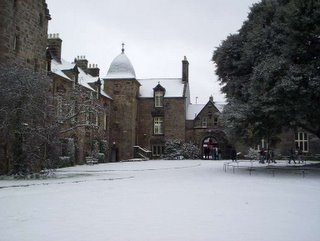DA VINCI CODE REVIEW: I finally got around to reading
The Da Vinci Code last fall. (I borrowed Grant Macaskill's copy, which he had bought from a charity shop, so both of us avoided the defilement of giving Dan Brown money.) The book has been in the news a good bit lately because of both the lawsuit and the upcoming movie. I've finally finished this brief review, which is so late that it's timely again. Warning: there are some spoilers below.
The book is fun. The writing is lousy, but the plot is well constructed and Brown keeps you guessing and wanting to know what comes next. Robert Langdon and Sophie Neveu are sympathetic characters and I usually wanted things to come out well for them (but see below). Intellectually the book is a couple of notches above, say,
The Mummy movie, but it gets too full of itself with its bogus scholarly pretensions. In
The Mummy, when Evelyn (Rachel Weitz) starts to blither about "Bambridge scholars" one can't help but cringe, but at least Rachel Weitz is good to look at, and we know anyway that before she gets out more than a few sentences brigands will come crashing through the door waving their scimitars and shooting the place up. (Then Evelyn will take a scimitar off of one of them and kill him with it. The bad guys will have machine guns and the good guys only revolvers, but nevertheless the baddies will miss completely and Evelyn's husband, Rick [Brendan Fraser], and her brother, Jonathan [John Hannah], will pick off numerous baddies. Also, at least once during the battle one or more goodies will leap through a glass window without getting a scratch.)
Unfortunately, Brown fails to follow this principle of administering his fake scholarship in small doses relieved by vigorous bouts of action. Rather, pages 304 to 367 or thereabouts consist of nonstop pseudo-intellectual drivel and well before I got to page 367 I was longing for Silas to burst in and shoot them all down so they would shut up.
Now in one sense, I don't hold this idiocy against Brown any more than I hold it against
The Mummy. They're both just stories and even though both are badly done, they're lots of fun. I do hold against him the pretty explicit claim that the historical evidence he presents in the book is real. Notably, the opening page lists as "Fact" that "All descriptions of artwork, architecture, documents and secret rituals in this novel are accurate." This just isn't so. He tries to get around this in the
common questions page on his website, but not with great success:
HOW MUCH OF THIS NOVEL IS TRUE?
The Da Vinci Code is a novel and therefore a work of fiction. While the book's characters and their actions are obviously not real, the artwork, architecture, documents, and secret rituals depicted in this novel all exist (for example, Leonardo Da Vinci's paintings, the Gnostic Gospels, Hieros Gamos, etc.). These real elements are interpreted and debated by fictional characters. While it is my belief that some of the theories discussed by these characters may have merit, each individual reader must explore these characters' viewpoints and come to his or her own interpretations. My hope in writing this novel was that the story would serve as a catalyst and a springboard for people to discuss the important topics of faith, religion, and history.
BUT DOESN'T THE NOVEL'S "FACT" PAGE CLAIM THAT EVERY SINGLE WORD IN THIS NOVEL IS HISTORICAL FACT?
If you read the "FACT" page, you will see it clearly states that the documents, rituals, organization, artwork, and architecture in the novel all exist. The "FACT" page makes no statement whatsoever about any of the ancient theories discussed by fictional characters. Interpreting those ideas is left to the reader.
This isn't correct. For example, he has the Dead Sea Scrolls containing "Gnostic Gospels" and calls the Scrolls "Christian records" (p. 351). Kindly show me a Gnostic Gospel among the Dead Sea Scrolls.
I don't want to belabor the historical inaccuracies in the book here, since they've been covered very thoroughly many times elsewhere. But for more information see
here and
here and
here and
here and
here and
here and
here and
here.
The bad thing about the book is that many people will read it and think the ridiculous claims in it are true -- and Brown himself is partly to blame for this and he could have mitigated the problem instead of making it worse. The good thing is that it has gotten a lot of people interested in the Bible and in actual ancient Jewish and Christian history and that may lead some of them to learn more from reputable sources. Plus, it's an amusing read.
